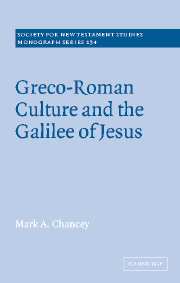Book contents
- Frontmatter
- Contents
- Preface
- Abbreviations
- Map of Galilee and northern Palestine
- Introduction
- 1 Galilee's early encounter with Hellenism
- 2 The Roman army in Palestine
- 3 The introduction of Greco-Roman architecture
- 4 The transformation of the landscape in the second and third centuries CE
- 5 The use of Greek in Jesus' Galilee
- 6 The coinage of Galilee
- 7 Greco-Roman art and the shifting limits of acceptability
- 8 Conclusion
- Appendix: Galilean names in the first century CE
- Select bibliography
- Index of passages
- Selective index of places
- Index of people and topics
4 - The transformation of the landscape in the second and third centuries CE
Published online by Cambridge University Press: 22 September 2009
- Frontmatter
- Contents
- Preface
- Abbreviations
- Map of Galilee and northern Palestine
- Introduction
- 1 Galilee's early encounter with Hellenism
- 2 The Roman army in Palestine
- 3 The introduction of Greco-Roman architecture
- 4 The transformation of the landscape in the second and third centuries CE
- 5 The use of Greek in Jesus' Galilee
- 6 The coinage of Galilee
- 7 Greco-Roman art and the shifting limits of acceptability
- 8 Conclusion
- Appendix: Galilean names in the first century CE
- Select bibliography
- Index of passages
- Selective index of places
- Index of people and topics
Summary
After the arrival of large, long-term Roman garrisons, Palestine's landscape was transformed as Greco-Roman urban and monumental architecture became common features in many cities. In this chapter, I will discuss some of the changes that characterized civic life in the second and third centuries. I begin with the adoption of new civic names and titles. Next, I provide an inventory of where Roman urban architecture appeared. Last, I consider the issue of who was responsible for the construction of these buildings. Throughout the chapter, I consider developments throughout Palestine in order to keep those in Galilee in perspective.
CIVIC TITLES AND NAMES
One effect of the heightened Roman presence in Palestine was the establishment of new colonies. Caesarea Maritima was elevated to colonial status by Vespasian shortly after the first revolt, taking the official name Colonia Prima Flavia Augusta Caesarea. The Roman colony of Aelia Capitolina had been founded at Jerusalem by 132 CE. Military veterans settled at both cities. Inscriptions show that Caesarea adopted Roman-style civic institutions, with duumviri, decurions, and pontifices, and Aelia Capitolina probably did likewise. Both cities placed Latin inscriptions on their coins. In the late second century and throughout the first half of the third, numerous cities were awarded the status of colony and a few received the still more vaunted title of “metropolis.” By then, however, the designation “colony” appears to have been purely honorific; the Romans had ceased to establish genuine colonies occupied by military veterans.
- Type
- Chapter
- Information
- Greco-Roman Culture and the Galilee of Jesus , pp. 100 - 121Publisher: Cambridge University PressPrint publication year: 2005



